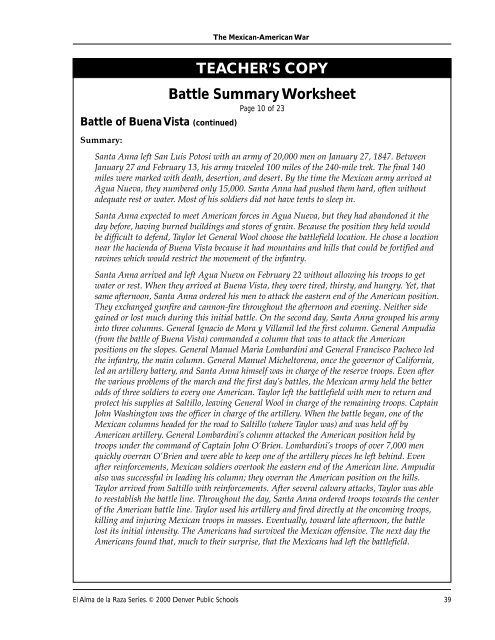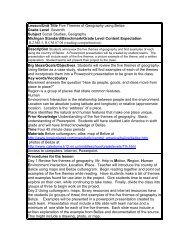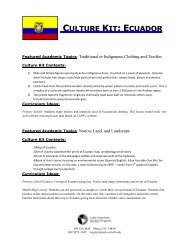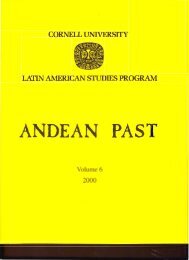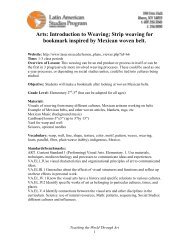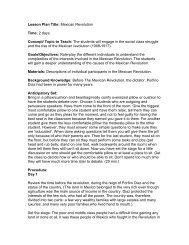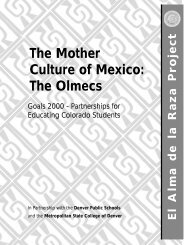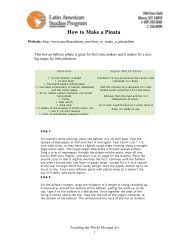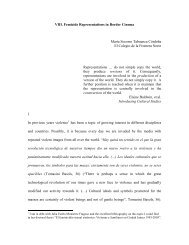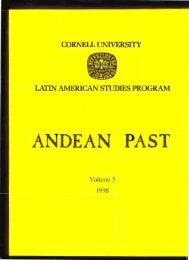The Mexican American War PDF - Denver Public Schools
The Mexican American War PDF - Denver Public Schools
The Mexican American War PDF - Denver Public Schools
You also want an ePaper? Increase the reach of your titles
YUMPU automatically turns print PDFs into web optimized ePapers that Google loves.
<strong>The</strong> <strong>Mexican</strong>-<strong>American</strong> <strong>War</strong><br />
Battle of Buena Vista (continued)<br />
Summary:<br />
TEACHER’S COPY<br />
Battle Summary Worksheet<br />
Page 10 of 23<br />
Santa Anna left San Luis Potosi with an army of 20,000 men on January 27, 1847. Between<br />
January 27 and February 13, his army traveled 100 miles of the 240-mile trek. <strong>The</strong> final 140<br />
miles were marked with death, desertion, and desert. By the time the <strong>Mexican</strong> army arrived at<br />
Agua Nueva, they numbered only 15,000. Santa Anna had pushed them hard, often without<br />
adequate rest or water. Most of his soldiers did not have tents to sleep in.<br />
Santa Anna expected to meet <strong>American</strong> forces in Agua Nueva, but they had abandoned it the<br />
day before, having burned buildings and stores of grain. Because the position they held would<br />
be difficult to defend, Taylor let General Wool choose the battlefield location. He chose a location<br />
near the hacienda of Buena Vista because it had mountains and hills that could be fortified and<br />
ravines which would restrict the movement of the infantry.<br />
Santa Anna arrived and left Agua Nueva on February 22 without allowing his troops to get<br />
water or rest. When they arrived at Buena Vista, they were tired, thirsty, and hungry. Yet, that<br />
same afternoon, Santa Anna ordered his men to attack the eastern end of the <strong>American</strong> position.<br />
<strong>The</strong>y exchanged gunfire and cannon-fire throughout the afternoon and evening. Neither side<br />
gained or lost much during this initial battle. On the second day, Santa Anna grouped his army<br />
into three columns. General Ignacio de Mora y Villamil led the first column. General Ampudia<br />
(from the battle of Buena Vista) commanded a column that was to attack the <strong>American</strong><br />
positions on the slopes. General Manuel Maria Lombardini and General Francisco Pacheco led<br />
the infantry, the main column. General Manuel Micheltorena, once the governor of California,<br />
led an artillery battery, and Santa Anna himself was in charge of the reserve troops. Even after<br />
the various problems of the march and the first day’s battles, the <strong>Mexican</strong> army held the better<br />
odds of three soldiers to every one <strong>American</strong>. Taylor left the battlefield with men to return and<br />
protect his supplies at Saltillo, leaving General Wool in charge of the remaining troops. Captain<br />
John Washington was the officer in charge of the artillery. When the battle began, one of the<br />
<strong>Mexican</strong> columns headed for the road to Saltillo (where Taylor was) and was held off by<br />
<strong>American</strong> artillery. General Lombardini’s column attacked the <strong>American</strong> position held by<br />
troops under the command of Captain John O’Brien. Lombardini’s troops of over 7,000 men<br />
quickly overran O’Brien and were able to keep one of the artillery pieces he left behind. Even<br />
after reinforcements, <strong>Mexican</strong> soldiers overtook the eastern end of the <strong>American</strong> line. Ampudia<br />
also was successful in leading his column; they overran the <strong>American</strong> position on the hills.<br />
Taylor arrived from Saltillo with reinforcements. After several calvary attacks, Taylor was able<br />
to reestablish the battle line. Throughout the day, Santa Anna ordered troops towards the center<br />
of the <strong>American</strong> battle line. Taylor used his artillery and fired directly at the oncoming troops,<br />
killing and injuring <strong>Mexican</strong> troops in masses. Eventually, toward late afternoon, the battle<br />
lost its initial intensity. <strong>The</strong> <strong>American</strong>s had survived the <strong>Mexican</strong> offensive. <strong>The</strong> next day the<br />
<strong>American</strong>s found that, much to their surprise, that the <strong>Mexican</strong>s had left the battlefield.<br />
El Alma de la Raza Series. © 2000 <strong>Denver</strong> <strong>Public</strong> <strong>Schools</strong> 39


